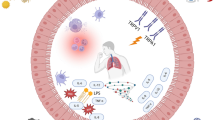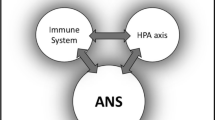Summary
Endorphins-like opiates-were found to increase temperature at very low doses and to decrease temperature at high doses. Not only the decreasing, but also the increasing effect on temperature, seems to be mediated through opiate receptors, since it proved to be antagonizable by naloxone and to be diminished in morphine-tolerant and-dependent animals. Like opiate-induced hyperthermia, both the pharmacological as well as the supposedly physiological increase in temperature induced by endorphins were strongly diminished in restrained animals. Hyperthermia induced by pyrogens, however, was not antagonizable by either naloxone or restraining of the animals. Maintenance of normal body temperature in animals being exposed to acute cold could not be disturbed by administration of naloxone. As a whole, such findings support the suggestion derived from our previous observation that physiologically induced naloxone-antagonizable hyperthermia may be a sensitive measure for endorphin release. However, endorphins although being potent hyperthermic modulators of temperature, do not seem to be directly involved in the central regulation of temperature. Instead, the physiologically induced increase in temperature by endorphins seems to represent some epiphenomenon of physiological events primarily initiated for physiological requirements other than the support of thermostability.
Similar content being viewed by others
References
Akil, H., Watson, S. J., Berger, P. A., Barchas, J. D.: Endorphins, β-LPH, and ACTH: biochemical, pharmacological and anatomical studies. In: Advances in biochemical psychopharmacology, Vol. 18 (E. Costa, M. Trabucchi, eds.). New York: Raven Press 1978
Banerjee, U., Feldberg, W., Lotti, V. J.: Effect on body temperature of morphine and ergotamine injected into the cerebral ventricles of cats. Br. J. Pharmac. Chemother. 32, 523–538 (1968)
Bläsig, J., Herz, A., Reinhold, K., Zieglgänsberger, S.: Development of physical dependence on morphine in respect to time and dosage and quantification of the precipitated withdrawal syndrome in the rat. Psychopharmacologia (Berl.) 33, 19–38 (1973)
Bläsig, J., Höllt, V., Meyer, G., Herz, A.: Relationship between tolerance to morphine and occupation of specific binding sites by morphine. In: Opiates and endogenous opioid peptideds (H. W. Kosterlitz, ed.), pp. 391–394. Amsterdam: Elsevier/North-Holland Biomedical Press 1976
Bläsig, J., Höllt, V., Bäuerle, U., Herz, A.: Involvement of endorphins in emotional hyperthermia of rats. Life Sci. 23, 2525–2532 (1978)
Bodnar, R. J., Kelly, D. D., Steiner, S. S., Glusman, M.: Stress-produced analgesia and morphine-produced analgesia: lack of cross-tolerance. Pharmacol. Biochem. Behav. 8, 661–666 (1978)
Clark, W. G.: Emetic and hyperthermic effects of centrally injected methionine-enkephalin in cats (39713). Proc. Soc. Exp. Biol. (N. Y.) 154, 540–542 (1977)
Clark, W. G., Harris, N. F.: Naloxone does not antagonize leukocytic pyrogen. Eur. J. Pharmacol. 49, 301–304 (1978)
Cox, B., Ary, M., Chesarek, W., Lomax, P.: Morphine hyperthermia in the rat: an action on the central thermostates. Eur. J. Pharmacol. 36, 33–39 (1976)
Feldberg, W., Milton, A. S.: Prostaglandin fever. In: The Pharmacology of Thermoregulation, pp. 302–310. Basel: Karger 1973
French, E. D., Vasquez, S. A., George, R.: Thermoregulatory response of the unrestrained cat to acute and chronic intravenous administration of low doses of morphine and to naloxone-precipitated withdrawal. Life Sci. 22, 1947–1954 (1978)
Gibson, R. D., Tingstad, J. E.: Formulations of a morphine implantation pellet suitable for tolerance-physical dependence studies in mice. J. Pharm. Sci. 59, 426–427 (1970)
Goldstein, A., Lowery, P. J.: Effect of the opiate antagonist naloxone on body temperature in rats. Life Sci. 17, 927–932 (1975)
Herz, A., Bläsig, J.: Analgesia, catatonia and changes in core temperature induced by opiates and endorphins — a comparison. In: Endorphins in Mental Health Research (E. Usdin, E. E. Bunney, jr., N. S. Kline, eds.), pp. 269–278. London: Macmillan Press 1979
Holaday, J. W., Wei, E., Loh, H. H., Li, C. H.: Endorphins may function in heat adaptation. Proc. Natl. Acad. Sci. USA 75, 2923–2927 (1978a)
Holaday, J. W., Loh, H. H., Li, C. H.: Unique behavioral effects of β-endorphin and their relationship to thermoregulation and hypothalamic function. Life Sci. 22, 1525–1536 (1978b)
Huidobro-Toro, J. P., Maglio, M., Way, E. L.: Single dose tolerance and dependence to β-endorphin (β-EN) in mice. Pharmacologist 19, 353 (1977)
Lomax, P.: Drugs and body temperature. In: Neurobiology (C. C. Pfeiffer, J. R. Smythies, eds.), pp. 1–43. New York: Academic Press 1970
Martin, G. E., Morrison, J. E.: Hyperthermia evoked by the intracerebral injection of morphine sulphate in the rat: the effect of restraint. Brain Res. 145, 127–140 (1978)
Martin, W. R., Jasinski, D. R., Mansky, P. A.: Naltrexone, an antagonist for the treatment of heroin dependence. Arch. Gen. Psychiatry 28, 784–791 (1973)
McGilliard, K. L., Tulunay, F. L., Takemori, A. E.: Antagonism by naloxone of morphine-and pentazocine-induced respiratory depression and analgesia and of morphine-induced hyperthermia. In: Opiates and Endogenous Opioid Peptides (H. W. Kosterlitz, ed.), pp. 281–288. Amsterdam: Elsevier/North-Holland Biomedical Press 1976
Myers, R. D.: Temperature regulation. In: Handbook of drug and chemical stimulation of the brain, pp. 237–301. New York: Nostrand Reinhold Comp. 1974
Roemer, D., Buescher, H. H., Hill, R. C., Pless, J., Bauer, W., Cardinaux, F., Closse, A., Hauser, D., Huguenin, R.: A synthetic enkephalin analogue with prolonged parenteral and oral analgesic activity. Nature 268, 547–549 (1977)
Rudy, T. A., Yaksh, T. L.: Hyperthermic effects of morphine: set point manipulation by a direct spinal action. Br. J. Pharmacol. 61, 91–96 (1977)
Sharkawi, M.: Morphine hyperthermia in the rat: its attenuation by physostigmine. Br. J. Pharmacol. 44, 544–548 (1972)
Spector, S., Ngai, S. H., Hempstead, J., Berkowitz, B. A.: Pharmacokinetics of naloxone in rats. In: Factors affecting the action of narcotics (M. I. Adler, I. Manara, R. Samanin, eds.), pp. 249–269. New York: Raven Press 1978
Teschemacher, H.: Endogenous ligands of opiate receptors (endorphins). In: Developments in Opiate Research, Vol. 14 (A. Herz, ed.), pp. 67–151. New York: Dekker 1978
Author information
Authors and Affiliations
Rights and permissions
About this article
Cite this article
Bläsig, J., Bäuerle, U. & Herz, A. Endorphin-induced hyperthermia: Characterization of the exogenously and endogenously induced effects. Naunyn-Schmiedeberg's Arch. Pharmacol. 309, 137–143 (1979). https://doi.org/10.1007/BF00501221
Received:
Accepted:
Issue Date:
DOI: https://doi.org/10.1007/BF00501221




